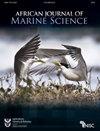An acoustic survey of beaked whale distribution at São Tomé and Príncipe, Gulf of Guinea, using an unmanned surface vessel
IF 1.4
4区 生物学
Q3 MARINE & FRESHWATER BIOLOGY
引用次数: 0
Abstract
The first records of beaked whales, including Cuvier’s beaked whale Ziphius cavirostris, are reported from an acoustic baseline survey in the territorial waters of the Democratic Republic of São Tomé and Príncipe, Gulf of Guinea, West Africa. The survey was carried out between late 2018 and early 2019 using an AutoNaut unmanned surface vessel (USV), which is propelled by the motion of waves and operated remotely via a satellite link. The USV towed a hydrophone array on a cable, and over the course of 75 days the USV completed 1 772 km of acoustic survey effort. Beaked whale encounters were not uncommon and occurred on 28 of the 75 survey days. They were widespread on the shelf edge and in oceanic habitats above the abyssal plain. The average water depth at which acoustic detections were recorded was 2 519 (SD 555) m (n = 43). Beaked whales were evenly distributed across areas with different seabed characteristics: the number of encounters recorded in areas characterised by seabed gradient and ruggedness did not differ from that expected after accounting for survey effort. The majority of acoustic detections were attributable to Cuvier’s beaked whales, based on spectral and temporal characteristics of click-train vocalisations. The results provide baseline information on the distribution of beaked whales and suggest that passive acoustic methods using a small USV are well-suited to surveys of this species group, possibly because beaked whales, which are sensitive to disturbance associated with underwater sound sources, are less likely to avoid small, quiet vessels than larger vessels.使用无人水面船对几内亚湾 o tom和Príncipe的喙鲸分布进行声学调查
第一批喙鲸的记录,包括居维叶喙鲸Ziphius cavirostris,是在西非几内亚湾的东民主共和国和Príncipe的领海进行的声学基线调查中报告的。该调查是在2018年底至2019年初期间使用AutoNaut无人水面船(USV)进行的,该船由波浪运动推动,通过卫星链路远程操作。USV用缆绳拖曳水听器阵列,在75天的过程中,USV完成了1772公里的声学调查工作。喙鲸的遭遇并不罕见,在75天的调查中有28天发生了。它们广泛分布于陆架边缘和深海平原之上的海洋栖息地。记录声波探测的平均水深为2 519 (SD 555) m (n = 43)。喙鲸均匀分布在具有不同海底特征的区域:在以海底梯度和崎岖为特征的区域记录的遭遇数量与考虑调查努力后的预期数量没有差异。根据咔嗒声的频谱和时间特征,大多数的声学探测可归因于居维叶喙鲸。研究结果提供了喙鲸分布的基线信息,并表明使用小型USV的被动声学方法非常适合对这一物种群体进行调查,可能是因为喙鲸对水下声源的干扰很敏感,与大型船只相比,它们不太可能避开小而安静的船只。
本文章由计算机程序翻译,如有差异,请以英文原文为准。
求助全文
约1分钟内获得全文
求助全文
来源期刊

African Journal of Marine Science
生物-海洋与淡水生物学
CiteScore
2.60
自引率
16.70%
发文量
17
审稿时长
6-12 weeks
期刊介绍:
The African (formerly South African) Journal of Marine Science provides an international forum for the publication of original scientific contributions or critical reviews, involving oceanic, shelf or estuarine waters, inclusive of oceanography, studies of organisms and their habitats, and aquaculture. Papers on the conservation and management of living resources, relevant social science and governance, or new techniques, are all welcomed, as are those that integrate different disciplines. Priority will be given to rigorous, question-driven research, rather than descriptive research. Contributions from African waters, including the Southern Ocean, are particularly encouraged, although not to the exclusion of those from elsewhere that have relevance to the African context. Submissions may take the form of a paper or a short communication. The journal aims to achieve a balanced representation of subject areas but also publishes proceedings of symposia in dedicated issues, as well as guest-edited suites on thematic topics in regular issues.
 求助内容:
求助内容: 应助结果提醒方式:
应助结果提醒方式:


